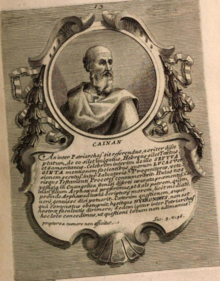
Methuselah was a biblical patriarch and a figure in Judaism, Christianity, and Islam. He is claimed to have lived the longest life, dying at 969 years of age. According to the Book of Genesis, Methuselah was the son of Enoch, the father of Lamech, and the grandfather of Noah. Elsewhere in the Bible, Methuselah is mentioned in genealogies in 1 Chronicles and the Gospel of Luke.

The Samaritan Pentateuch, also called the Samaritan Torah, is the sacred scripture of the Samaritans. Written in the Samaritan script, it dates back to one of the ancient versions of the Torah that existed during the Second Temple period. It constitutes the entire biblical canon in Samaritanism.
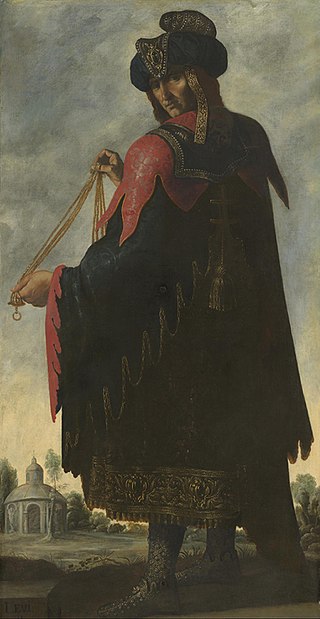
Levi was, according to the Book of Genesis, the third of the six sons of Jacob and Leah, and the founder of the Israelite Tribe of Levi and the great-grandfather of Aaron, Moses and Miriam. Certain religious and political functions were reserved for the Levites.

Peleg is mentioned in the Hebrew Bible as one of the two sons of Eber, an ancestor of the Ishmaelites and the Israelites, according to the Generations of Noah in Genesis 10–11 and 1 Chronicles 1.
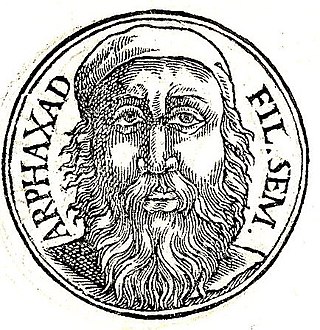
Arpachshad, alternatively spelled Arphaxad or Arphacsad, is one of the postdiluvian men in the Shem–Terah genealogy. The name is recorded in the Book of Genesis in the Hebrew Bible and subsequently copied in different biblical books, including the Gospel of Luke in the New Testament.

Mahalalel is an Antediluvian patriarch named in the Hebrew Bible. He is mentioned in the Sethite genealogy as the grandfather of Enoch and subsequently the ancestor of Noah.
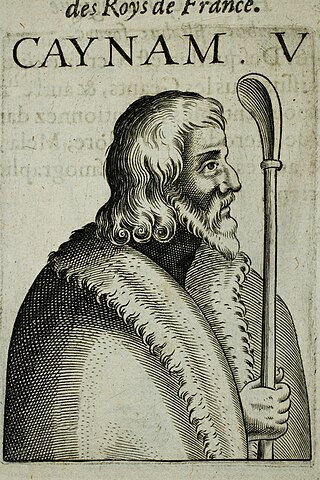
Kenan is an Antediluvian patriarch first mentioned in the Book of Genesis in the Hebrew Bible.
The genealogies of Genesis provide the framework around which the Book of Genesis is structured. Beginning with Adam, genealogical material in Genesis 4, 5, 10, 11, 22, 25, 29–30, 35–36, and 46 moves the narrative forward from the creation to the beginnings of the Israelites' existence as a people.

Anno Mundi, abbreviated as AM or A.M., or Year After Creation, is a calendar era based on the biblical accounts of the creation of the world and subsequent history. Two such calendar eras of notable use are:
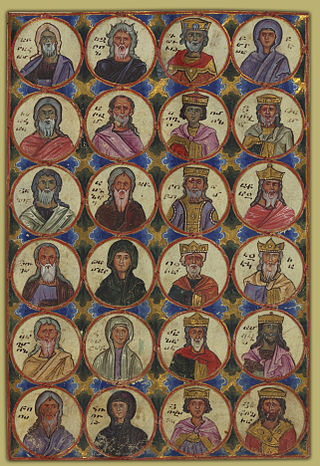
The New Testament provides two accounts of the genealogy of Jesus, one in the Gospel of Matthew and another in the Gospel of Luke. Matthew starts with Abraham and works forwards, while Luke works back in time from Jesus to Adam. The lists of names are identical between Abraham and David, but differ radically from that point. Matthew has twenty-seven generations from David to Joseph, whereas Luke has forty-two, with almost no overlap between them or with other known genealogies. They also disagree on who Joseph's father was: Matthew says he was Jacob, while Luke says he was Heli.

Serug was the son of Reu and the father of Nahor, according to Genesis 11:20–23. He is also the great-grandfather of Abraham, thus the ancestor of the Ishmaelites and the Israelites.

According to the Torah, Kehath or Kohath was the second of the sons of Levi and the patriarchal founder of the Kehathites, one of the four main divisions of the Levites in biblical times. In some apocryphal texts, such as the Testament of Levi and the Book of Jubilees, Levi's wife, Kehath's mother, is Milkah, a daughter of Aram.
"Generations of Adam" is a genealogical concept recorded in Genesis 5:1 in the Hebrew Bible. It is typically taken as the name of Adam's line of descent going through Seth. Another view equates the generations of Adam with material about a second line of descent starting with Cain in Genesis 4, while Genesis 5 is taken as the "generations of Noah".

Enos or Enosh is a figure in the Book of Genesis in the Hebrew Bible. He is described as the first son of Seth who figures in the Generations of Adam, and is also referred to within the genealogies of 1 Chronicles.

Jared or Jered, in the Book of Genesis, was a sixth-generation descendant of Adam and Eve. His primary history is recounted in Genesis 5:18–20.

Lamech was a patriarch in the genealogies of Adam in the Book of Genesis. He is part of the genealogy of Jesus in Luke 3:36.

Selah, Salah or Sala or Shelah is an ancestor of the Israelites and Ishmaelites according to the Table of Nations in Genesis 10. He is thus one of the table's "seventy names". He is also mentioned in Genesis 11:12–15, 1 Chronicles 1:18–24, and Luke 3:35–36.

Since early modern times, a number of biblical ethnonyms from the Table of Nations in Genesis 10 have been used as a basis for classifying human racial and national identities. The connection between Genesis 10 and contemporary ethnic groups began during classical antiquity, when authors such as Josephus, Hippolytus and Jerome analyzed the biblical list.

1 Chronicles 1 is the first chapter of the Books of Chronicles in the Hebrew Bible or the First Book of Chronicles in the Old Testament of the Christian Bible. The book is compiled from older sources by an unknown person or group, designated by modern scholars as "the Chronicler", and had the final shape established in late fifth or fourth century BCE. The content of this chapter is the genealogy list from Adam to Israel (=Jacob) in the following structure: Adam to Noah ; Noah's descendants from his three sons Shem, Ham, and Japheth: the Japhethites, Hamites, Semites ; the sons of Abraham ; the sons of Isaac. This chapter belongs to the section focusing on the list of genealogies from Adam to the lists of the people returning from exile in Babylon.
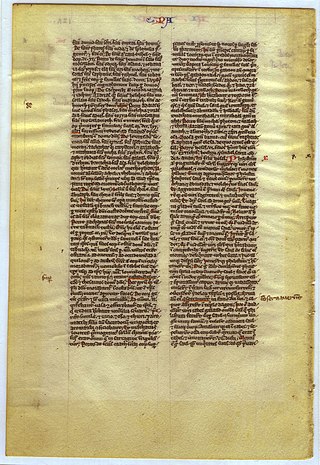
1 Chronicles 8 is the eighth chapter of the Books of Chronicles in the Hebrew Bible or the First Book of Chronicles in the Old Testament of the Christian Bible. The book is compiled from older sources by an unknown person or group, designated by modern scholars as "the Chronicler", and had the final shape established in late fifth or fourth century BCE. This chapter focuses on the tribe of Benjamin, especially the family of King Saul. It belongs to the section focusing on the list of genealogies from Adam to the lists of the people returning from exile in Babylon.
